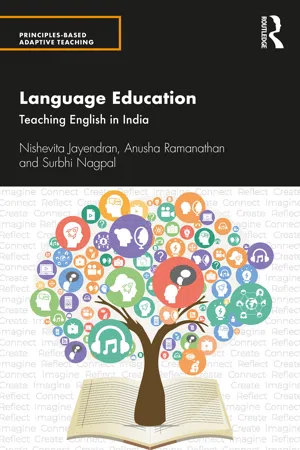
Language Education
Teaching English in India
- 232 pages
- English
- ePUB (mobile friendly)
- Available on iOS & Android
About this book
This book situates the teaching and learning of language in general, and English in particular, within the sociocultural context of India. It engages with current scholarship in literacy studies and the pedagogies of language acquisition and learning.
The volume discusses the cultural, discursive and sociopolitical functions of language education and the teaching of English in Indian schools. It examines the importance of adopting flexible pedagogical and multimodal strategies in teaching vocabulary; grammar; literary genres like fiction, poetry and drama; rhetorical discourses; and communicative English to learners for whom English is not one of their home language(s). It also discusses pragmatic approaches to curriculum design for communicative competence and critical literacy rooted in theoretical principles of language education. The authors analyse issues relevant to secondlanguage acquisition; English language teaching (ELT); emergent, adult and critical literacies; and critical pedagogies in language and literature.
Written in an accessible style, the book comes with case studies, exercises and additional references to support an independent exploration of the fields. This book will be of interest to students and teachers of language, literature and education, as well as teachers and educators in schools and universities. It is also of relevance to policymakers, non-governmental organisations and public and private sector bodies that work in the fields of language and literacy.
Frequently asked questions
- Essential is ideal for learners and professionals who enjoy exploring a wide range of subjects. Access the Essential Library with 800,000+ trusted titles and best-sellers across business, personal growth, and the humanities. Includes unlimited reading time and Standard Read Aloud voice.
- Complete: Perfect for advanced learners and researchers needing full, unrestricted access. Unlock 1.4M+ books across hundreds of subjects, including academic and specialized titles. The Complete Plan also includes advanced features like Premium Read Aloud and Research Assistant.
Please note we cannot support devices running on iOS 13 and Android 7 or earlier. Learn more about using the app.
Information
1
The notion of language
An overview
‘When I use a word,’ Humpty Dumpty said in a rather scornful tone, ‘it means just what I choose it to mean – neither more nor less.’ ‘The question is,’ said Alice, ‘whether you can make words mean so many different things.’ ‘The question is,’ said Humpty Dumpty, ‘which is to be master – that’s all.’Lewis Carroll, Through the Looking-Glass (1871)
Objectives
- gain an overview of language through select thinkers from philosophy, ethnography and linguistics;
- understand the relationship between language and thought;
- identify ways in which language, culture and identity relate to each other; and
- engage critically with contemporary perspectives on New Literacy Studies (NLS) and critical literacy.
What is language?
………………………………………………………………………………………………………………
………………………………………………………………………………………………………………
………………………………………………………………………………………………………………
………………………………………………………………………………………………………………
………………………………………………………………………………………………………………
………………………………………………………
- Language and Structure
- Language and Symbolisation
- Language and Representation
- Language and Culture
- Language and Literacy
Language and structure
Table of contents
- Cover
- Half Title
- Series Page
- Title Page
- Copyright Page
- Dedication
- Table of Contents
- List of figures
- List of tables
- Series editors’ note
- Foreword
- Acknowledgements
- Abbreviations
- Introduction
- Chapter 1: The notion of language: An overview
- Chapter 2: Language and policy: English studies in India
- Chapter 3: Language acquisition and language learning: An overview
- Chapter 4: Perspectives and approaches to language and literacy
- Chapter 5: Teaching of language – I (communicative English)
- Chapter 6: Teaching of language – II (language through literature)
- Chapter 7: Teaching literature: Fiction, poetry and drama
- Chapter 8: Assessment and evaluation for language and literature
- Postscript
- Further reading
- Index